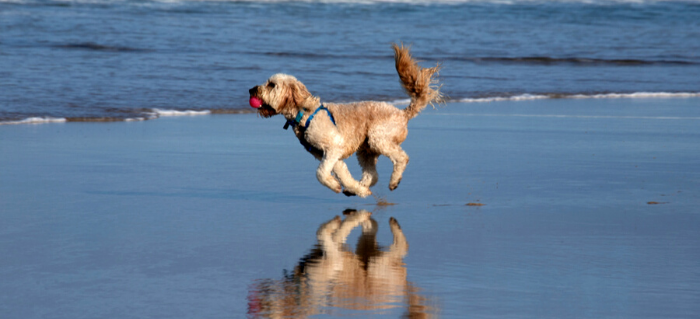Do you have a naturally anxious dog? Just like children, our pets can get nervous about nearly anything… a loud storm, a knock at the door, or pretty much any kind of incitement. It can make us, as owners, feel incredibly helpless.
It’s hard watching your dog go through all of that anxiety, especially if you don’t know what you can do to help. We’ve all experienced that ourselves here at WINPRO Pet, which is why we wanted to give you a list of a few tips and tricks that you can use today to learn how to calm your dog down. Ready to get started?
Signs Your Dog May Be Anxious
Because dogs are unable to tell us how they feel and what is making them nervous, it’s up to us as pet owners to be able to recognize the signs that they may be stressed so that we can act as quickly as possible.
This can be incredibly unique to each dog, so the first and most important tip we can give you on how to calm a dog down is to really get to know your own dog. What seems to stress them out? Knowing their triggers, and how they tend to show their anxiety, is essential in learning how to help them.
According to the American Kennel Club, there are three categories of anxiety triggers in dogs - fear related (like thunderstorms or going to the vet), separation (which affects around 14% of dogs) and age (similar to how dementia impacts elderly humans).
The type of anxiety your dog is experiencing may directly affect how they show that they’re anxious… and different symptoms may be seen in different situations with different triggers.
When it comes to those symptoms, here are a few of the more common. Again, knowing your dog is the most important way to really discern whether or not they’re anxious, experiencing other feelings, or just struggling with behavioral issues.
- Aggression
- Panting
- Drooling
- Repetitive and/or compulsive behavior (like licking)
- Excessive barking
- Depression
- Restlessness
- Bathroom accidents in the house
- Destructive behavior
- Pacing
Why Your Approach Matters
Before we get into how to calm your dog down, let’s talk quickly about the approach. Dogs are incredibly intuitive creatures, a trait that they’ve developed through centuries of experience as both predator and prey.
That means that they are really good at picking up how you’re feeling, and they take their cues from your energy on how they’re also supposed to react. If you meet an anxious dog with more anxiety, it only worsens the issue.
Think of how you would like to be treated if you’re feeling particularly nervous about something. Before you approach your dog when they’re anxious, take a deep breath and calm down your breathing. Once you’re feeling both calm and confident, that’s the time to help your dog feel the same.
Tip #1 : Create A Safe Space
If your dog experiences most of their anxiety in the home, it’s imperative that you work to create a safe space for them.
For a lot of dogs, this is their kennel. Some owners are resistant to kennel training their dogs out of concern that it may be cruel, but really, kennel training is one of the nicest things that you can do for your dog in the long run.
If you think about it, dogs aren’t all that far removed from their wild ancestors. And, much like a lot of other animals, they are naturally drawn to smaller areas that they feel they can more easily protect. In the wild, this would be a den. For domesticated dogs, this is the kennel.
It’s never too late to crate train a dog, either. Creating a kennel space that they can retreat to when they are feeling anxious, and one where they can be sure no one will bother them, gives them a retreat that gets them away from their source of anxiety.
That also means that the crate should not be disturbed if the dog has put themselves there, especially by children… that’s how accidental bites happen.
Tip #2 : Take A Close Look At Their Diet
Think about how you feel when you eat fast food versus how you feel after eating a healthy, well balanced meal. Significantly different, right? It’s the same way for dogs. It may be cheaper in the short term to feed your dog a less expensive diet, but it can actually cost a lot more in the long term when it comes to veterinary costs.
Feeding your dog a healthy, well-balanced diet that supports their body can also help keep them from being as anxious.
Natural diets keep their blood sugar more stable than a diet full of processed ingredients, and also keeps their bowels more regular to help potentially reduce household accidents.
You may also want to consider a supplement to help manage the symptoms of anxiety that can’t be treated with behavior modification.
For instance, WINPRO Calming uses a proprietary blend of animal blood proteins, taurine (which is also helpful for heart related concerns), and theanine to help promote a sense of calm by reducing inflammation in your dog’s body. WINPRO Calming can be a great addition to helping your pet calm down, especially from the inside out.
Tip #3 : Walk Away The Anxiety
Whether or not the source of anxiety for your pet is in the house, when your dog starts to show symptoms, take them for a walk! This works on two different levels.
One, learning how to calm a dog down involves removing them from their immediate triggers. Walking literally gets them away from what’s stressing them out, so that they can also work to calm themselves down.
Two, walking is a great distraction. Let your dog lead, and keep the leash as slack as possible. Change directions frequently, take a new route… let your dog be in charge (as long as it’s safe, of course). Gently praise them using a soft, calm voice while you’re walking, too.
This all helps them gain confidence, which is pivotal to feeling less anxious overall. And it’s great exercise for both of you as well, especially in a time when dogs tend to be more overweight than ever.
Tip #4 : Distract Them
In situations where you can’t easily leave or take your dog out for a walk, try using a novel distraction to change their focus. Dogs need stimulation to feel happy and safe and, obviously, when they’re not feeling safe it can lead to anxiety.
If you keep safe toys around the house that you can use to help distract them from anxiety, like bones, chews, tennis balls, etc., it gives you the ability to snap them out of it and gives them something else to direct all those anxious feelings toward.
This can be especially helpful for dogs who deal with separation anxiety, as long as those toys aren’t a choking hazard and can be safely chewed while you are not around.
To Sum It All
Having an anxious dog can also make you anxious. But knowing how to calm a dog down gives you options to redirect all that nervous energy and make life much more peaceful for both of you.
Whether that involves behavioral modification, WINPRO supplements, dietary changes, or a combination of all of them, learning what specifically triggers your dog and how they showcase that mental health is pivotal in changing both of your lives for the better.
Sources:
Dog Anxiety: What Dog Owners Need to Know | AKC
Crate Training Benefits: Why A Crate Is Great For You And Your Dog | AKC



